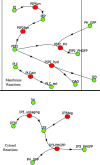Kinetic analysis of receptor-activated phosphoinositide turnover
- PMID: 12771127
- PMCID: PMC2199375
- DOI: 10.1083/jcb.200301070
Kinetic analysis of receptor-activated phosphoinositide turnover
Abstract
We studied the bradykinin-induced changes in phosphoinositide composition of N1E-115 neuroblastoma cells using a combination of biochemistry, microscope imaging, and mathematical modeling. Phosphatidylinositol-4,5-bisphosphate (PIP2) decreased over the first 30 s, and then recovered over the following 2-3 min. However, the rate and amount of inositol-1,4,5-trisphosphate (InsP3) production were much greater than the rate or amount of PIP2 decline. A mathematical model of phosphoinositide turnover based on this data predicted that PIP2 synthesis is also stimulated by bradykinin, causing an early transient increase in its concentration. This was subsequently confirmed experimentally. Then, we used single-cell microscopy to further examine phosphoinositide turnover by following the translocation of the pleckstrin homology domain of PLCdelta1 fused to green fluorescent protein (PH-GFP). The observed time course could be simulated by incorporating binding of PIP2 and InsP3 to PH-GFP into the model that had been used to analyze the biochemistry. Furthermore, this analysis could help to resolve a controversy over whether the translocation of PH-GFP from membrane to cytosol is due to a decrease in PIP2 on the membrane or an increase in InsP3 in cytosol; by computationally clamping the concentrations of each of these compounds, the model shows how both contribute to the dynamics of probe translocation.
Figures









Similar articles
-
Ethanol effects on bradykinin-stimulated phosphoinositide hydrolysis in NG 108-15 neuroblastoma-glioma cells.Alcohol. 1989 Nov-Dec;6(6):475-9. doi: 10.1016/0741-8329(89)90055-4. Alcohol. 1989. PMID: 2557051
-
The Pleckstrin Homology Domain of PLCδ1 Exhibits Complex Dissociation Properties at the Inner Leaflet of Plasma Membrane Sheets.ACS Chem Neurosci. 2021 Jun 16;12(12):2072-2078. doi: 10.1021/acschemneuro.1c00248. Epub 2021 May 28. ACS Chem Neurosci. 2021. PMID: 34048227
-
Bradykinin analogues: differential agonist and antagonist activities suggesting multiple receptors.Br J Pharmacol. 1988 May;94(1):3-5. doi: 10.1111/j.1476-5381.1988.tb11492.x. Br J Pharmacol. 1988. PMID: 2900038 Free PMC article.
-
Bradykinin B(2) receptor endocytosis, recycling, and down-regulation assessed using green fluorescent protein conjugates.J Pharmacol Exp Ther. 2001 Apr;297(1):19-26. J Pharmacol Exp Ther. 2001. PMID: 11259523
-
Acute regulation of the receptor-mediated phosphoinositide signal transduction pathway.J Lipid Mediat Cell Signal. 1996 Sep;14(1-3):157-68. doi: 10.1016/0929-7855(96)00521-4. J Lipid Mediat Cell Signal. 1996. PMID: 8906558 Review.
Cited by
-
Phosphoinositide 5- and 3-phosphatase activities of a voltage-sensing phosphatase in living cells show identical voltage dependence.Proc Natl Acad Sci U S A. 2016 Jun 28;113(26):E3686-95. doi: 10.1073/pnas.1606472113. Epub 2016 May 24. Proc Natl Acad Sci U S A. 2016. PMID: 27222577 Free PMC article.
-
Quantitative properties and receptor reserve of the IP(3) and calcium branch of G(q)-coupled receptor signaling.J Gen Physiol. 2013 May;141(5):521-35. doi: 10.1085/jgp.201210886. J Gen Physiol. 2013. PMID: 23630337 Free PMC article.
-
Integration of modeling with experimental and clinical findings synthesizes and refines the central role of inositol 1,4,5-trisphosphate receptor 1 in spinocerebellar ataxia.Front Neurosci. 2015 Jan 21;8:453. doi: 10.3389/fnins.2014.00453. eCollection 2014. Front Neurosci. 2015. PMID: 25653583 Free PMC article. Review.
-
Cytosolic inositol 1,4,5-trisphosphate dynamics during intracellular calcium oscillations in living cells.J Cell Biol. 2006 Jun 5;173(5):755-65. doi: 10.1083/jcb.200512141. J Cell Biol. 2006. PMID: 16754959 Free PMC article.
-
Hippocampal neurons maintain a large PtdIns(4)P pool that results in faster PtdIns(4,5)P2 synthesis.J Gen Physiol. 2022 Mar 7;154(3):e202113001. doi: 10.1085/jgp.202113001. Epub 2022 Feb 18. J Gen Physiol. 2022. PMID: 35179558 Free PMC article.
References
-
- Agranoff, B.W., P. Murthy, and E.B. Seguin. 1983. Thrombin-induced phosphodiesteratic cleavage of phosphatidylinositol bisphosphate in human platelets. J. Biol. Chem. 258:2076–2078. - PubMed
-
- Allbritton, N.L., T. Meyer, and L. Stryer. 1992. Range of messenger action of calcium ion and inositol 1,4,5-trisphosphate. Science. 258:1812–1815. - PubMed
-
- Balla, T., T. Bondeva, and P. Varnai. 2000. How accurately can we image inositol lipids in living cells? Trends Pharmacol. Sci. 21:238–241. - PubMed
-
- Berridge, M.J. 1993. Cell signalling. A tale of two messengers. Nature. 365:388–389. - PubMed
-
- Berridge, M.J., and R.F. Irvine. 1984. Inositol trisphosphate, a novel second messenger in cellular signal transduction. Nature. 312:315–321. - PubMed

